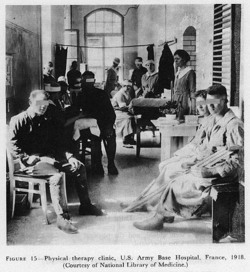One of the central arguments brought forth by groups opposing direct access to physical therapists is that of safety. This argument implies that the only safe way for those with musculoskeletal dysfunction to receive care is to have all complaints first checked by a physician. This is in line with the traditional role of physicians as gatekeepers. But, does this argument hold water, and is there any evidence that can guide us as to the safety of physical therapists in a direct access role? Before you read on, you may want to check out yesterday’s NYT article about the public’s eroding confidence in physicians.
Examining the Logic
Before we get to any review of evidence, let’s first bring up a point of logic and examine the reality of physicians and musculoskeletal dysfunction. In medical school, students spend very little time learning orthopaedic examination, and rightly so. The skill of physicians lies in managing the integrated, complex patients, with medical problems responsive to pharmaceutical management. This takes time to learn. So much time, that by the time medical students become residents, they are good at a lot of things, but only have basic knowledge of musculoskeletal complaints. This lack of orthopaedic knowledge is routinely supported by research (such as 7% of Harvard medical students passing a competency exam). By the time students are in residency, the specialized nature of their learning effectively precludes further development of these skills for all but orthopaedic residents.
Alternatively, physical therapists almost singularly specialize in musculoskeletal dysfunction and movement. As a biased “consumer,” I would want to see the professional with the most training in the area of my problem. The anti-direct access safety argument does not dispute this variation in training. It lies more central to the ability of physical therapists to detect serious medical problems, such as when that low back pain is cancer, or when that shoulder pain is a cardiac problem. No doubt, physicians are good at this. But, are physical therapists? If evidence can show that physical therapists are competent diagnosticians, then the logic behind the safety argument falls apart, right?
Examining the Evidence
Conveniently, physical therapists in military settings have been seeing patients via direct access for years, and can provide a case to study safety in this setting. This 2005 study by Moore et al. examined over 50,000 patients seen through direct access over 4 years and concluded that patients are at minimal risk for negligent care, with no adverse events resulting from PT management. Granted, some evidence exists that those in uniformed services may be above average in musculoskeletal management, but this could be offset by the complex and varied conditions seen in military clinics, as I can attest to first-hand. When physical therapists in a general private practice population were studied, correct decisions differentiating between patients with musculoskeletal vs. medical conditions were high, and even higher when the physical therapist was a board-certified clinical specialist. When directly comparing physical therapist competency in musculoskeletal management with physicians, the results speak for themselves:
“Experienced physical therapists had higher levels of knowledge in managing musculoskeletal conditions than medical students, physician interns and residents, and all physician specialists except for orthopaedists. Physical therapist students enrolled in doctoral degree educational programs achieved significantly higher scores than their peers enrolled in master’s degree programs. Furthermore, experienced physical therapists who were board-certified in orthopaedic or sports physical therapy achieved significantly higher scores and passing rates than their non board-certified colleagues.”
I hope that I have at least provided enough evidence to support my enthusiastic “Yes!” that I began this post with. Perhaps, I have also provided enough evidence to suggest that some risk exists when seeking general physician care for musculoskeletal complaints, given their lower levels of training and competency compared to orthopaedists and physical therapists.
Now that we have concluded that direct access can be done safely, perhaps more safely by physical therapists who are board-certified specialists and have clinical doctorates, we can move on and examine some other issues central to direct access. Next up: reimbursement.
- Direct Access: An Overview
- Direct Access: Is it safe?
- Direct Access: Reimbursement, also see Part II
- Direct Access: The Netherlands
- Direct Access: Making it Work
- Direct Access: The Future
Photo by harryalverson.







